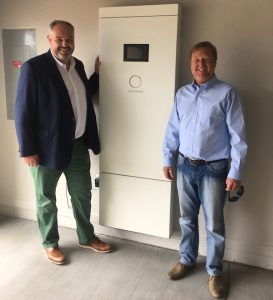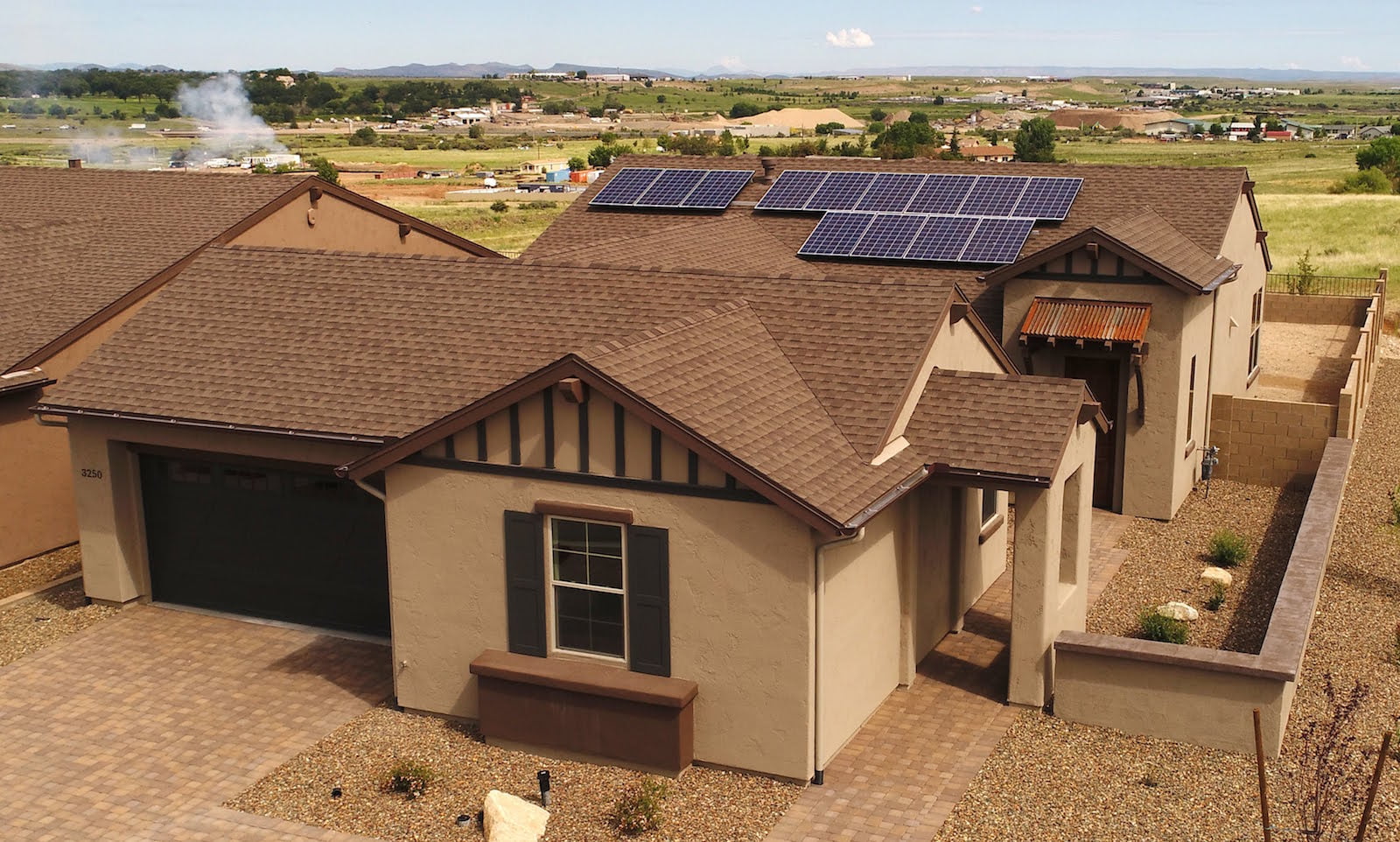For almost 20 years, Mandalay Homes has been building in Arizona. We sell homes in a number of communities and at different trim levels. Depending on the community, our homes range from 1,350 to over 3,000 square feet with prices starting at about $240,000 and up. Regardless of the community, our homes have Home Energy Ratings of 50 or better. Since 2012 all our homes are built to the Zero Energy Ready Home standard, so that the building and equipment can be fully powered with the addition of a renewable solar system.
In our most recent community, called Jasper, every home will be outfitted with solar panels and batteries, creating an on-site, virtual power plant. These new grid-optimized models will offer $25 per month energy bills that buyers will be clamouring for.
Mandalay Homes Builds Zero Energy Ready Homes That Are “Cost Neutral”
Over the last five years of developing and refining, we have worked very hard to drive down the cost of innovative, energy saving products and services in our homes. Today, we bring to market homes that are effectively cost neutral compared to our competitor builder who offers homes built to the current Energy Star 3.0 specification. We concentrate on four areas to drive costs down and enable us to offer a home performance level beyond any of our local competition while remaining market competitive.
Build Relationship with Suppliers
We cultivate strong relationships with our trade partners and vendors. By viewing our trade partners and vendors as investment partners, we create mutual value to the relationship during the bidding process. A lot of what we do in the high-performance building field could be viewed as odd, or intimidating to an average tradesperson. We use those situations to invest in our trades so they can learn these new energy-efficient processes. For example, in many parts of the country, spray foam insulation is quite a bit more expensive than more conventional fiberglass or cellulose. For us, it is actually cheaper when you consider all the details, labor, and other processes you can delete when you adopt this type of product. Our spray foam contractor was relatively small and looking to grow the business. We worked with them to better understand the building science aspects of the service they offer and help them leverage material purchases based on volume. In exchange, we received lower installation costs that fit our pricing model. We helped our trade partner increase sales volume, expand services and operate more efficiently. In this situation, we collaborated through simple investments in knowledge and commitment and we both benefited in the end.
Harness the Energy Rater
We take full advantage of the the expertise and services of our energy rater and other industry resources to source the best products for the price we can invest. A builder’s relationship with their rater is a pretty special thing. A rater that is truly vested in the success of their builder has much to offer to the process. They have access to vendors and manufacturers that a builder may not otherwise be able to leverage. They also bring expertise to the table that helps in sourcing the right products for the job. Sometimes these are products or techniques that are not obvious.
Our energy rater helps us make choices related to energy, health, durability, renewables, etc. Armed with that knowledge base, our team can start by asking the right questions of vendors and manufacturers to get to the best products for the job. The rater partner also has access via his network to new technologies coming down the line. We have been early adopters of several new products that give us a performance edge. By forming relationships early with suppliers of innovative products we can obtain better pricing in exchange for field testing and data gathering. Innovative new products are all around us everyday looking for a way into the market. Don’t be afraid to partner on some of these emerging technologies.
Create a Sound Building Envelope
The building envelope is the core of everything else we do. We firmly believe that a strong foundation of thermal efficiency, air tightness, durability, and safety, will make all other advancements in energy efficiency more achievable. In our non-grid-optimized communities, we advertise our base homes at HERS rating of 50, but our actual average rating is 47. The HERS ratings of our base home in our grid-optimized communities, such as Jasper, is typically around 29.
Thermal efficiency and air tightness of the homes envelopes are better than code and even better than ENERGY STAR. We insulate all our slabs with R10 rigid foam or closed cell spray foam. We use open cell spray foam in all our walls. We we standardize on sealed, cathedralized attics, too. By sealing the attic space we can use that space for HVAC and other equipment. Equipment and ducts in conditioned space are important features from an efficiency and comfort standpoint. On air tightness, we were the first builder in the nation to partner with and standardize the use of AeroBarrier for air sealing. We install AeroBarrier on every home we build, and we seal our homes down to less than a 0.3 ACH50 before drywall. Great insulation details along with this incredible air tightness opens doors for smaller, more efficient HVAC equipment as well as superior indoor air quality through a tighter shell and good energy recovery ventilation.
Innovate for Cost Reductions
We trade innovation dollars when the situation allows us to do so in order to source lower cost products or services. One example of the trading dollars strategy is in ventilation. We have used energy recovery ventilators (ERVs) for balanced ventilation in our homes for about 5 years now. The first ERV we purchased was right around $2000 for equipment and, when fully installed, it was an almost $4000 investment – an investment we made gladly and one which we still feel is the best ventilation strategy for our buyers. But today things are different. There are many more players in the ERV field and prices have come down dramatically. An ERV with the same performance and specifications (Broan ERV S100) that we were buying four years ago is now $495. In addition, now that our HVAC trade has gotten used to these systems and understands their installation and operation better, cost to install and commission has come down, too. Total package costs today for our ERV, fully installed is less than $1500 a home.
Mandalay Homes Uses Solar and Batteries To Benefit Homebuyers
Batteries will be the future, because solar energy is rapidly becoming the cheapest form of electricity, even though electric utilities struggle with how to manage this new energy resource. Here’s how a grid-optimized home uses on-site batteries to connect the utility and its customers.

Sonnen’s eco 10 battery is joined by Mandalay Homes CEO Dave Everson (right) and Sonnen CEO Christoph Ostermann.
Everyone knows that the sun only shines so many hours a day. However we, humans want our lights to work 24/7 – more so when the sun is not out, in fact. This situation puts the utility in a bind. In many parts of the country an excess of renewable energy is generated during sunny hours. So much so, that the grid has no place to send it. On the flip side, the grid is extremely taxed most afternoons and evenings as the sun is going down and homes start being used very heavily by occupants. Technical minutia aside, the problem is this. We produce a lot of clean, renewable energy at times that we don’t necessarily need it: we use a lot of energy at precisely the time when clean, renewables are not able to be harvested. A battery and intelligent energy management system allows us to take that clean energy that is harvested all day and store it so that the home’s occupants can use it well into the dark hours of the night. It’s a pretty simple concept but one that has historically been extremely expensive and failed to provide benefit to the consumer.
The situation has now changed with rapid advancement and declining costs of solar panels and on-site batteries. This is especially true in the southwestern part of the country. Battery storage has become much less expensive as the technology has evolved. Homes, overall, have become more efficient, which helps drive the cost of adoption down, too. And finally, electric utilities are beginning to respond to these energy crises by changing rate plans. We are starting to see time of use and demand level rate plans sweep the country as a mechanism that utilities use in an effort to flatten the load curve on the grid. Tate plans that incentivize power use at certain times and ask for decreased usage at other times make battery storage a viable cost-savings tool for consumers. Storing excess power in on-site batteries during times when a home needs very little energy and then drawing that energy later, we are able to reduce the average monthly utility bill by nearly 80%. This allows us to completely avoid energy purchases during the peak demand period when utility costs are highest.
By optimizing the home to use less power as a base asset, optimizing the solar array/battery storage system to that asset, and then optimizing the system to maximize the utility rate plan savings, we can offer the best-sized system for the lowest upfront investment costs and deliver the lowest utility bills possible to our buyers year-round. The investment dollars on the purchase are far outweighed by the cash that buyers save every month by way of low, low utility bills. The average utility bill for a 2200 sq. ft., cost neutral, zero energy ready home, without solar collectors, is modeled at $25-$35 per month year-round. Compared to the average Arizona utility bills of about $180 per month, this is a substantial monthly savings that our buyers really appreciate.


Fred Roensch says:
Overall a good review of aspects to consider when building an energy efficient and near off-grid home.
It is a good article. Now some picky and not so picky criticism:
1. It should be made clear if the home costs stated exclude land, road, well, septic, utility hookups, etc. Or is that to be assumed (you know what assume means).
2. When the decision was made to use spray foam rather than cellulose or fiberglass insulation was the environmental impact from raw material extraction, manufacture, distribution, installation, VOC emission, global warming potential (GWP) impact, recycle potential and lifecycle costs considered and compared-not just the initial price and installation cost? In fact, I would suggest they clearly describe what process they used to decide to use spray foam rather than only mentioning initial material and installation cost comparison.
3. You use the term “investment we made” concerning HEV. Don’t you really mean the home owner made the investment, or did the contractor really pay for it and not charge the home owner?
4. I would suggest changing “batteries will be the future” to “batteries are the future”.
It was a good article just needed, IMHO, some editing.
P.S. I am not an editor-far from it-just a concerned reader.